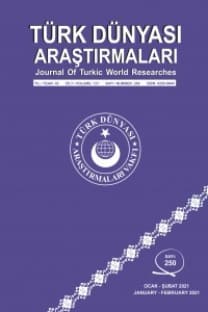Türk toplum yapısı ve "etnikleşme"
The structure of Turkish society and to be ethnic
___
- Andrews, Peter Alford, Türkiye’de Etnik Gruplar, çev. Mustafa Küpüşoğlu, ss. 1-3, 1992.
- Anter, Musa, Hatıralarım, 2. basım, ss. 176-177, Ağustos 1991.
- Bala, Mirza, “Gürcistan Maddesi”, İslâm Ansiklopedisi, s. 837-845.
- Bruinessen, Martin Van, Ağa, Şeyh ve Devlet, s. 153-160, Özge Yayınları, Tarih yok, 1992.
- Gellner, Ernest, Uluslar ve Ulusçuluk, ss. 129-130, 1992.
- Genel Nüfus Sayımı, 24.10.1965.
- Green, Arnold, Sociology, p. 242, 1960.
- Kırzioğlu, Fahrettin M., Lazlar-Çanarlar, Türk Tarih Kongresi, II. Seksiyon, I. Cilt, ss. 420-445, Ankara, 1972.
- Marden, Charles F., Minorities in America, p. 42, 1952.
- Örnek, Sedat Veyis, Etnoloji Sözlüğü, 1971.
- Parsons, Talcott, The Social System, p. 172, 1959.
- Rose, Arnold M., Racial and Ethnic Relations in Merton and Nisbet, Centemporal of Social Problems, p. 326, 1961.
- Ross, Aarand, Jumalga Kars Ja Erzurum, Maarjamaa, Lund, 1975.
- Selen, Hamit Sadi, Türkiye’nin Etnik Bünyesi, Ders Notları, SBF, 1957-1958, Ankara.
- Smith, Lynn, Social Problems, p. 421, 1957.
- Sorokin, Pitirim A., Sociology, Culture and Personality, p. 201, 1947.
- Soysü, Hale, Kavimler Kapısı-1, Kaynak Yayınları, ss. 1-18, Kasım 1992, İstanbul.
- Svanberg, İngvar, A Bibliograph of The Turkish-Speaking Tribal Yörüks, pp. 1-2, Uppsala, 1982.
- Svanberg, İngvar, Kazakska Flyktinger I Turkie, Uppsala Universitet, 1980, pp. 1-80.
- Togan, Zeki Velidi, Umumi Türk Tarihine Giriş, s. 275, cilt: 1, 1946, İstanbul.
- Türkdoğan, Orhan, “Türkiye’de Etnik Yerleşim ve Kars”, Milliyet Gazetesi, 14.7.1975.
- Türkdoğan, Orhan, Kars’ta Bir Eston Köyü, Atatürk Üniversitesi, 1976, Erzurum.
- Türkdoğan, Orhan, Köy Sosyolojisinin Temel Sorunları, ss. 167-216, İkinci Baskı, 1977, Ankara.
- Türkdoğan, Orhan, Malakanların Toplumsal Yapısı, Atatürk Üniversitesi Yayınları, 1971, Erzurum.
- Türkiye İstatistik Yıllığı, 1964/1965.
- Winick, Charles, Dictionary of Anthropology, 1961.
- Yasa, İbrahim, Türkiye’nin Toplumsal Yapısı (Etnik Gruplar), ss. 165- 167, Ankara.
- Zanden, James W. Vander, Sociology, Fourth Edition, p. 293, 1979.
- ISSN: 0255-0644
- Yayın Aralığı: 6
- Başlangıç: 1979
- Yayıncı: Türk Dünyası Araştırmaları Vakfı
Tanzimat Dönemi'nde Osmanlının yenileşme sürecine bir bakış
Milli güç, bileşenleri ve vasıtaları
Türk toplum yapısı ve "etnikleşme"
II. Abdülhamid Devrinde gayrimüslimlerin eğitimlerine dair yayımlanmamış iki belge
Şiraz'dan Trabzon'a bir kültür köprüsü Murtaza Trabzoni ve Urfi şerhleri
Gölbaşı halk kültüründe halk inanışlarının eski Türk inançları bağlamında değerlendirilmesi
Ankara-Polatlı ilçesi hakkında bilgiler
